Kangasala
Kangasala (Finnish pronunciation: [ˈkɑŋŋɑsˌʔɑlɑ]) is a city in Finland, 16 kilometers east of Tampere. It was founded in 1865. The city has a population of 32,117 (31 July 2020)[2] and covers an area of 870.86 square kilometres (336.24 sq mi) of which 212.83 km2 (82.17 sq mi) is water.[1] The population density is 48.81 inhabitants per square kilometre (126.4/sq mi).
Kangasala | |
|---|---|
City | |
| Kangasalan kaupunki Kangsala stad | |
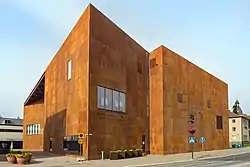 Kangasala-talo, cultural building in Kangasala | |
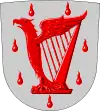 Coat of arms | |
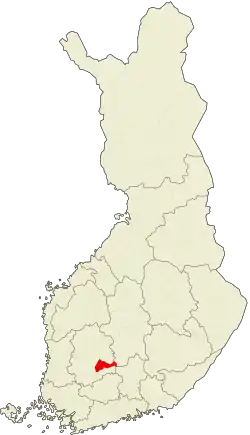 | |
| Coordinates: 61°28′N 024°04′E | |
| Country | |
| Region | Pirkanmaa |
| Sub-region | Tampere sub-region |
| Charter | 1865 |
| Government | |
| • City manager | Oskari Auvinen |
| Area (2018-01-01)[1] | |
| • Total | 870.86 km2 (336.24 sq mi) |
| • Land | 658.02 km2 (254.06 sq mi) |
| • Water | 212.83 km2 (82.17 sq mi) |
| Area rank | 130th largest in Finland |
| Population (2020-07-31)[2] | |
| • Total | 32,117 |
| • Rank | 36th largest in Finland |
| • Density | 48.81/km2 (126.4/sq mi) |
| Population by native language | |
| • Finnish | 98.3% (official) |
| • Swedish | 0.3% |
| • Others | 1.4% |
| Population by age | |
| • 0 to 14 | 20.7% |
| • 15 to 64 | 64.7% |
| • 65 or older | 14.7% |
| Time zone | UTC+02:00 (EET) |
| • Summer (DST) | UTC+03:00 (EEST) |
| Municipal tax rate[5] | 20% |
| Website | www.kangasala.fi |
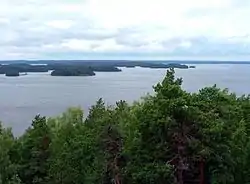
It is known in Finland for the beauty of its natural environment, as described by Zacharias Topelius in his poem "A Summer's Day in Kangasala" (which was later set to music by Gabriel Linsén). It is also known for its mansions, such as Liuksiala, where the Swedish queen Karin Månsdotter lived as widow, and Wääksy. Kangasala has a long history of tourism.
The lakes Roine, Längelmävesi and Vesijärvi are located in Kangasala. They are mentioned in the poem by Topelius, and Vesijärvi is the lake where the scenic view described in the lyrics is situated.
The municipality of Sahalahti was consolidated into Kangasala on 1 January 2005, and the municipality of Kuhmalahti on 1 January 2011.[6]
Tourism
Springs
Kangasala was a popular destination in the 18th century. The waters of the Kuohu Spring (Kuohunlähde) were believed to have healing effects. At that time, refreshing in a health spa, bathing, taking outdoor exercise and "taking the waters" was fashionable amongst the aristocracy. It was also the reason why the first tourists came to Kangasala to spend their holidays there.
A water well building was built by the Kuohu Spring, which was later followed by a separate restaurant and hotel.[7] Even people from more distant places came to refresh themselves there, preferably at least once a year. At the same time, travelers had the opportunity to exchange news, discuss with each other and find out about the latest trends of fashion. Spa tourism can probably be considered a predecessor of modern holidaymaking. At that time, however, it was primarily a pastime of the noble and the prosperous bourgeoisie only.
Ridges
The golden age of spa tourism lasted about a hundred years, as interest in health springs began to decline in the 1840s. However, a new ideology had arrived from Germany: Romanticism. The artists of the Romantic period admired nature and praised its beauty. Artists were drawn to Kangasala to view the landscapes. The many eskers and moraines and plentiful lakes made a permanent impression on many. Amongst university students, wandering their homeland's natural environment became a way of showing patriotic love.
The ridge panoramas stunned people, even monarchs. In 1775 the king of Sweden, Gustaf III was so taken by the scenery of Syrjänkorkee ridge that he believed it to have been the very place where Satan tempted Jesus and promised him all the wonders of the world. Syrjänkorkee also impressed the Russian tsar, Grand duke of Finland, Alexander I in 1819. Thus it was later renamed Keisarinharju (Emperor's Ridge).
In addition to Keisarinharju there are at least three other ridges that are popular sightseeing locations because of their panoramas. The largest and highest one of these is Kirkkoharju, also called Helaamäki, stretching from Vatiala to the church of Kangasala. For centuries it has been a renowned place for spending time. Also Kuohunharju (Kuohu Ridge) and Vehoniemenharju (Vehoniemi Ridge) are well known for their views. Haralanvuori, or Haralanharju, located in Suinula, northern Kangasala, instead is a rocky hill despite its second name. Nevertheless, it has its own role in the development of Finnish national romanticism.
A Summer's Day in Kangasala
In the summer of 1853 Helsinki suffered a cholera epidemic. Zacharias Topelius escaped the disease by retreating to the peaceful countryside. He visited lieutenant-colonel Aminoff's farm near Haralanvuori with his female acquaintance, Lotta Lindqvist. Topelius became fond of the views from the "Harjula ridge" and wrote his famous poem "A Summer's Day in Kangasala". Later Gabriel Linsén composed a melody for the poem. From 1995 the melody has been the provincial hymn of the Pirkanmaa region, and it is one of the most widely known Finnish melodies.
Since Topelius's times the Finnish national landscape has often been experienced just like in his depiction: with wild, dark forests and lakes with silver-glistening surfaces reflecting a blue, fluffy-clouded sky.
Landscapes
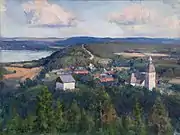
The landscapes of Kangasala impressed other Finnish authors than Topelius. Even before Topelius the natural environment of the region was admired by poets like Frans Mikael Franzén, Johan Jakob Nervander, Emil von Qvanten and Johan Ludvig Runeberg. The beauty of Finnish nature was described in letters and travel accounts.[8]
These landscapes were a source for an arising sense of nationality and arts were a way of concretizing the admiration and pride directed at them. In particular, the early 19th-century art of painting with its idyllic portraits of country and nature expresses the intellectual world of Romanticism. Countryside, fields, forests, hills, ridges, lakes and rivers have a central role in them. The average city-dwellers two hundred years ago were probably just as alienated from nature as their modern-day suburban counterparts.
In the 19th century, Kangasala's landscapes were painted by several famous painters. Finland didn't actually have independent artistic circles in the beginning of the century. The earliest portrayers of the local landscape include Emanuel Thelning, a Swede sent to Kangasala by baron Gustaf Mauritz Armfelt after he himself had visited the healing spring of Kuohu in 1811 and the German Carl von Kügelgen, royal painter of Alexander I, who painted at least three paintings representing Kangasala. His workpiece Vues pittoresques de la Finlande which includes 15 lithographs can be considered the start of Finnish landscape painting. At least the Hermitage in St. Petersburg contains pieces of art by von Kügelgen.
Other artists who painted Kangasala were Werner Holmberg, Einar Ilmoni, Eero Järnefelt, Hjalmar Munsterhjelm, Sigurd Wettenhovi-Aspa and Magnus von Wright who painted six paintings on Kangasala in the 1860s.
The invention of dry plate photography in 1882 made taking photographs easier and cheaper than before. Also landscape photography started to gain popularity. As far as is known, the first actual landscape photographs in Kangasala were taken by Gustin Lojander in 1893. His series of photographs presented the landscapes and sightseeings of Kangasala.
The increased popularity of landscape photography decreased artists' interest in the province of Tavastia (Häme). The search for the roots of Finnishness now turned towards Karelia (Karjala). Still, Kangasala wasn't forgotten by artists. The number of local artists – who often were landscapists of their home district – kept on growing all the time. Photographs helped in making the whole nation aware of Kangasala's landscapes. At the end of the 19th century, advances in the printing press made it possible to spread the pictures throughout the country in the form of affordable picture postcards.
Observation towers
The artists' descriptions of Kangasala lured more and more travelers to the parish. People had to climb high, even up the trees, to be able to enjoy the views. Although the ridgetops were relatively treeless at that time – because of the sawmill industry's great demand for wood – the construction of observation towers was considered necessary to provide the multiplying tourist hordes with new experiences. All the most popular lookout spots except Kuohunharju got their own observation towers in the 1880s or 1890s. The first observation tower was built on Keisarinharju in 1881. A panoramic pavilion had been built there at the time of the visit of Alexander I but it had already vanished by the 1850s. The towers at Haralanharju and Keisarinharju were destroyed by an arsonist in 2006 and 2007. Now only the towers at Vehoniemenharju and Kirkkoharju remain but plans were already in progress for rebuilding both towers after barely a year had gone by from the first arson.
The ridges of Kangasala and Tampere are part of the same ridge formation. Travelers often used to visit both the ridges of Kangasala and Pyynikinharju (Pyynikki Ridge) in Tampere. Together they were the most popular tourist attractions in Western Finland. In 1890, approximately 800 visitors came to Kangasala, 1,200–1,400 visited Pyynikki and Imatra, the most popular tourist attraction in Finland that time, was a destination of about 5,000 tourists. These figures seem small but it has to be noted that there were no amusement parks and festivals, fairs and other major happenings were rarely organized. Most of the travelers spent their holidays in nature. People looked for a spiritual connection with their fatherland in "the wilderness".
The ideological conceptions created by artist had a great influence on Finnish sense of nationality but so had also such everyday-sounding things as picture postcards and the lake views from the observation towers. When the period of Russification began at the end of the 19th-century Finnish nature worked as an upbringing force for national self-esteem and as a unifier of Finnish culture. Kangasala played a great role in that development.
Notable residents
- Karin Hansdotter, mistress of King John III of Sweden, was given the Wääksy Manor in 1561.
- Karin Månsdotter, queen of Sweden, lived in the Liuksiala Manor until her death in 1612
- Finnish politician and journalist Agathon Meurman was born and lived in Kangasala, and owned the Liuksiala manor.
- Finnish author Jalmari Finne was born and lived in Kangasala.
- Finnish actor Markku Peltola lived in Kangasala.
- A Finnish Internet hit Marko Vanhanen lives in Kangasala.
- Finnish educator Sofia Hagman, founder and manager of the first Folk high school in Finland.
See also
References
- "Area of Finnish Municipalities 1.1.2018" (PDF). National Land Survey of Finland. Retrieved 30 January 2018.
- "Suomen virallinen tilasto (SVT): Väestön ennakkotilasto [verkkojulkaisu]. Heinäkuu 2020" (in Finnish). Statistics Finland. Retrieved 13 September 2020.
- "Population according to language and the number of foreigners and land area km2 by area as of 31 December 2008". Statistics Finland's PX-Web databases. Statistics Finland. Retrieved 29 March 2009.
- "Population according to age and gender by area as of 31 December 2008". Statistics Finland's PX-Web databases. Statistics Finland. Retrieved 28 April 2009.
- "List of municipal and parish tax rates in 2011". Tax Administration of Finland. 29 November 2010. Retrieved 13 March 2011.
- "1.1.2011 yhdistyvien kuntien uudet nimet". Kunnat.net (in Finnish). Helsinki: Suomen Kuntaliitto. 2 July 2010. Retrieved January 1, 2011.
- Jalmari Meurman: Kangasalan terveyslähde, pages 8-9; Tampereen Kirjapaino-Osakeyhtiö 1935
- Fewster, Derek (2006). Visions of Past Glory: Nationalism & the Construction of Early Finnish History. Finnish Literature Society. ISBN 9517467877.
External links
| Wikimedia Commons has media related to Kangasala. |
- City of Kangasala – Official website
 Kangasala travel guide from Wikivoyage
Kangasala travel guide from Wikivoyage
